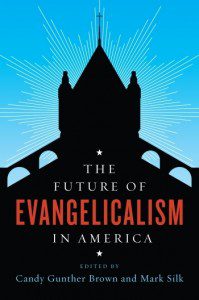Nearly twenty years ago, Christian Smith assessed American evangelicalism as “embattled but thriving.”
Nowadays, just “embattled” seems more apt for the preeminent impulse in the *history of American religion (*at least for much of that history). From the rise of the “Nones” to the collapse of the Religious Right to declines in church membership, the strength of American evangelicalism is on the wane.
Not so fast, say contributors to The Future of American Evangelicalism. The title alone makes me breathe a sigh of relief. We do indeed have a future!
 As Candy Gunther Brown explains, evangelicalism has done anything but crater in recent years. Instead, in recent decades evangelicalism has become the dominant form of Protestantism (and, in many respects, Christianity) in the United States. For example, the Pew Research Center found that the Christian share of the U.S. population declined from 78 percent to 71 percent between 2007 and 2014. The evangelical share of the population declined just one percent, however, and evangelicals gained “market share” among Protestants and grew in absolute numbers as well. Many mainline Protestants and a good many Catholics as well identify themselves as either “born again” or “evangelicals.”
As Candy Gunther Brown explains, evangelicalism has done anything but crater in recent years. Instead, in recent decades evangelicalism has become the dominant form of Protestantism (and, in many respects, Christianity) in the United States. For example, the Pew Research Center found that the Christian share of the U.S. population declined from 78 percent to 71 percent between 2007 and 2014. The evangelical share of the population declined just one percent, however, and evangelicals gained “market share” among Protestants and grew in absolute numbers as well. Many mainline Protestants and a good many Catholics as well identify themselves as either “born again” or “evangelicals.”
Mainline denominations have indeed cratered in terms of membership, but evangelicals have largely held their own. Some denominations, such as the Southern Baptist Convention, are losing members, but the growth of non-denominational churches has sky-rocketed (one in ten religiously affiliated Americans now belong to a nondenominational church).
Brown concludes that “the steady growth of evangelicalism has occurred at the expense of mainline denominations.” Hmm. I don’t know. It’s probably true that a good number of Americans from “mainline” backgrounds embraced evangelical movements and churches in the 1970s and 1980s, but I don’t think evangelical growth at mainline expense is a justified main conclusion from this data. Mainline Protestantism has declined primarily because of low birth rates and its failure to retain those children into adulthood. Also, I anticipate evangelical numbers (relative, if not absolute) will decline in the decades ahead. Still, it’s nice to have some sense that evangelicalism might persist through my lifetime. Good news for blog readership.
A few other morsels from this volume:
– Michael Hamilton presents American evangelicalism as “a synthesis of traditional evangelical Protestantism and American popular culture.” This basic point does much to explain evangelicalism’s staying power and malleability (for better and worse).
– Chris Armstrong observes that evangelicalism “subordinat[es] ecclesial forms to the direct, unmediated experience of God.” Again, this points to the “plasticity” of evangelicalism, its “chameleonic” nature. Also, although it is still the case that many evangelicals make their home within mainline denominations, that subordination of ecclesial forms suggests that evangelicalism is corrosive of denominational identity and stability.
– Armstrong, in a rather nice turn of phrase, explains that evangelicalism inculcates an “allergy to mediation in worship.” An allergy to tradition as well. Thus, evangelicals have brought us preaching in plain language, moving or mawkish praise songs (depending on one’s perspective), and young people driving their elders to distraction with blue jeans, guitars, and decibels.
– Roger Olson helpfully distinguishes between “evangelicalism as an ethos and as a movement.” I have argued elsewhere that as a movement, post-WWII evangelicalism has run its course. That’s true of evangelicalism as 1) a cohesive response to both fundamentalism and liberal Protestantism; 2) a cultural and political movement increasingly aligned with the Republican Party since the mid-1970s. As an “ethos” or impulse, by contrast, evangelicalism is hardly finished.
– Amy Black writes that “the recent alignment between evangelicals and Republicans, although still quite strong, is showing some signs of weakening.” While most evangelicals will vote for Trump in 2016, it is quite possible that his loathsomeness will drive some elsewhere or keep them at home. Another critical change: as E.J. Dionne has argued, evangelicals have lost clout within the GOP, and it’s hard to see that coming back anytime soon.
– Timothy Tseng argues that pre-WWII “fundamentalist separation from their denominations and retreat from mainstream American culture” left evangelicals ill-equipped and uninterested in engaging racial and ethnic diversity in meaningful ways.
Altogether, The Future of Evangelicalism in America predicts that recent trends will continue. American Protestantism will become more evangelical. Evangelicalism will become more fractured, diverse, Pentecostal, and non-denominational.
How diverse can evangelicalism become while remaining identifiably evangelical? Several of the above-mentioned authors lean on the Bebbington quadrilateral (biblicism, crucicentrism, conversionism, and activism), a testimony to the durability and utility of that definition of evangelicalism. “The label ‘evangelical,'” observes Candy Gunther Brown, “may come to mean so many different things that it becomes no more useful than denominational labels are now in predicting theological, spiritual, social, or political views.” Irrespective of the label’s ongoing utility, the characteristics of the evangelical ethos will persevere.
We’re far beyond the heyday of the post-WWII evangelical movement, but the evangelical ethos that has persistently shaped American Christianity for much of the last three centuries is, if not exactly “thriving,” still powerful.













